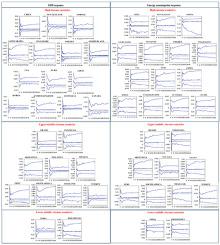Journal of Cleaner Production ( IF 9.7 ) Pub Date : 2021-02-10 , DOI: 10.1016/j.jclepro.2021.126265 Qiang Wang 1, 2 , Fuyu Zhang 1, 2

|
China is the first major economy to show a recovery after a slowdown induced by the COVID-19 pandemic. This work aims to explore what the China’s economic recovery after the COVID-19 pandemic means for the economic growth and energy consumption of the other countries using the global VAR quarterly data. In the long term, spillover effects of China’s economic growth have the most obvious impact on upper-middle-income countries’ economic growth (0.17%), followed by the economic growth of lower-middle-income countries (0.16%) and high-income countries (0.15%). However, the spillover effect of China’s economic growth has the most significant impact on energy consumption in high-income countries (0.11%–0.45%), followed by energy consumption in upper-middle-income countries (0.08%–0.33%) and in lower-middle-income countries (−0.02%–0.05%). Our results indicate upper-middle-income countries will benefit the most from China’s economic recovery post-COVID-19, followed by lower-middle-income countries and high-income countries. The spillover effect of China’s economic recovery post-COVID-19 brings the most obvious impact on the increase in energy consumption in high-income countries, followed by middle-income countries. It also should be noted that the spillover effect of China’s economic growth does not necessarily lead to an increase in energy consumption lower-middle-income countries. Generally, the spillover effect of China’s economic recovery on other countries’ economic growth is much more than other countries’ energy consumption.










































 京公网安备 11010802027423号
京公网安备 11010802027423号